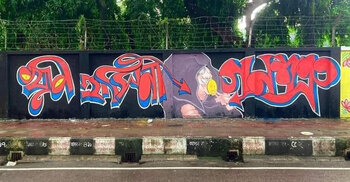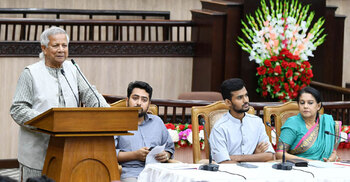Let the walls speak: The visual history of resistance

At Dhaka University, the walls have become more than mere boundaries—they've transformed into powerful symbols of resistance. Covered in graffiti and wall writings, they tell the story of an uprising that led to the fall of Sheikh Hasina's government on August 5, 2024, which protesters call the 36th of July. The once heavily political slogans have given way to a new kind of art, etched with the urgency of change and the pain of forgotten memories.

For decades, walls at DU bore the marks of political slogans from ruling party student organizations or leftist groups, each pushing their agendas. The BNP’s Chhatra Dal once dominated, and for the last 15 years, the Chhatra League’s slogans filled these spaces under Awami League rule. But those days feel distant now.
A nation united
No one could have predicted the sudden collapse of Sheikh Hasina’s government. On August 5, 2024, millions took to the streets alongside students from universities, schools, colleges, and madrasas under the call of the anti-discrimination student movement. The country, seemingly united, demanded the end of Hasina's reign. The pressure culminated in her resignation, and she left for India the same day.

Now, a month into the interim government’s rule, reform and change are evident across various sectors. Yet, the students’ involvement has not waned. They’ve taken charge—cleaning the streets, organizing traffic, and, importantly, adorning walls with revolutionary artwork and slogans. These walls, once marked by political propaganda, are now covered with expressions of hope and remembrance.
Words of resistance
In the early days of August, protesters wiped clean the graffiti of the Chhatra League in DU. In its place, they began writing poems, songs, and slogans—some hastily, under the threat of police or attacks. Slogans like "Dafa Ek Daabi Ek—Khuni Hasinar Padatyag" (One point, one demand, resignation of killer Hasina), "Raktachosha Hasina (Bloodsucker Hasina)," and "Stepdown Hasina" covered the walls.
“We wrote those in haste, always under fear,” says Badiul Haque, a DU student. “There was fear of police, of Chhatra League attacks. Most of the time, we’d scribble quickly as processions went by. The writings weren’t polished, but they carried the fire of revolution.”

Since August 5 or July 36, however, a different kind of art has taken over. Students from various art schools spent days painting the walls, capturing scenes of the revolution and the pain of the months leading to Hasina's fall. The image of Abu Sayeed, a protester shot while holding his chest, stands proudly on the walls of DU. The poignant question, "Does anyone need water?" echoes the scene of protesters in need. And, the infamous July 36 calendar and portraits of Sheikh Hasina serve as lasting reminders of the uprising.
A legacy in paint
For many students, these wall writings are more than just art. "These graffiti help us remember the bloody months of July and August, and also bring back the memory of the July uprising,” says Taslima Anjum, a DU student. “We’ve been through a bloody revolution, but we’re also now engaged in rebuilding the state. When we feel overwhelmed, these walls remind us of the spirit of rebellion.”

Though some believe educational institutions should focus more on academic content—quotes from scholars, messages of learning—the graffiti serves a deeper purpose. In a nation where student movements have often driven political change, DU’s walls are more than just stone. They’re a reflection of the country’s pulse.
As Taslima puts it, "When we see these writings and paintings, we’re reminded of our mission. We must carry the memories of the martyrs and continue to build a nation where our heads remain high in the global arena."

In a time of upheaval, these walls remind everyone who passes by that change is possible, and it begins here, at Dhaka University.





